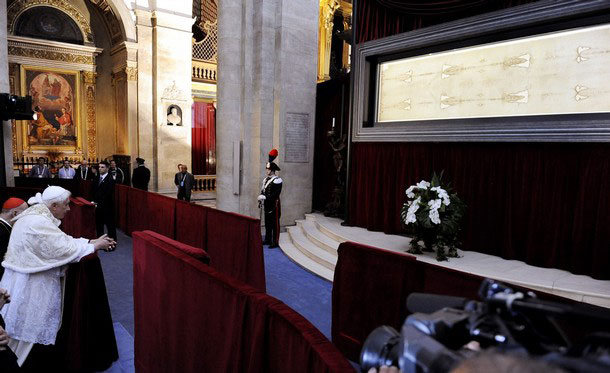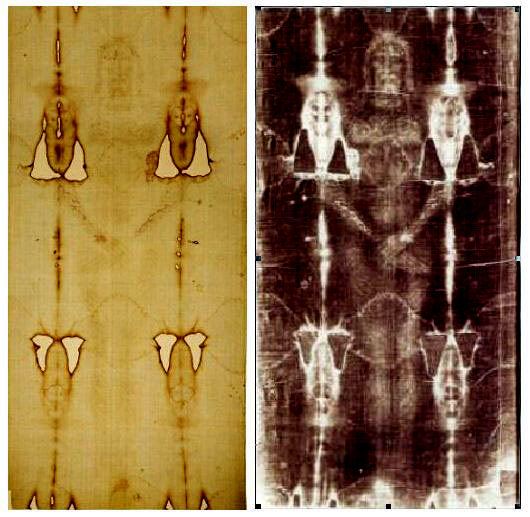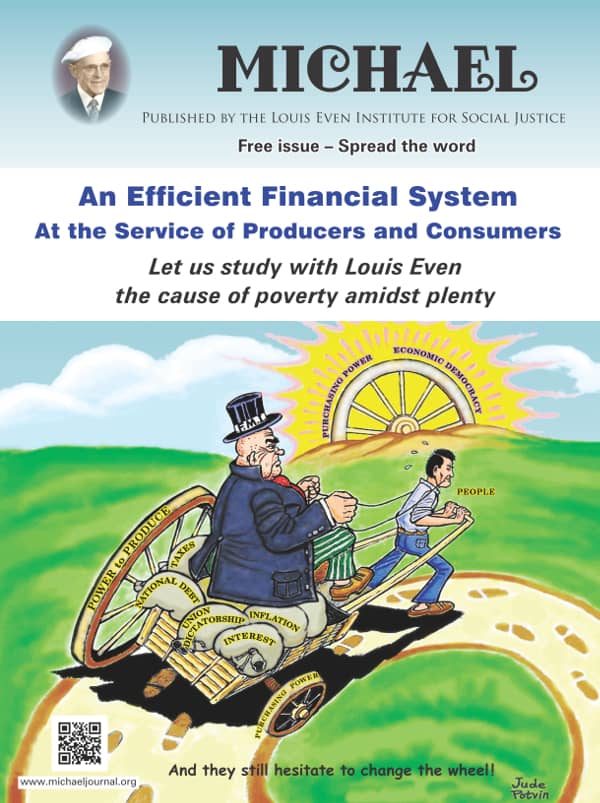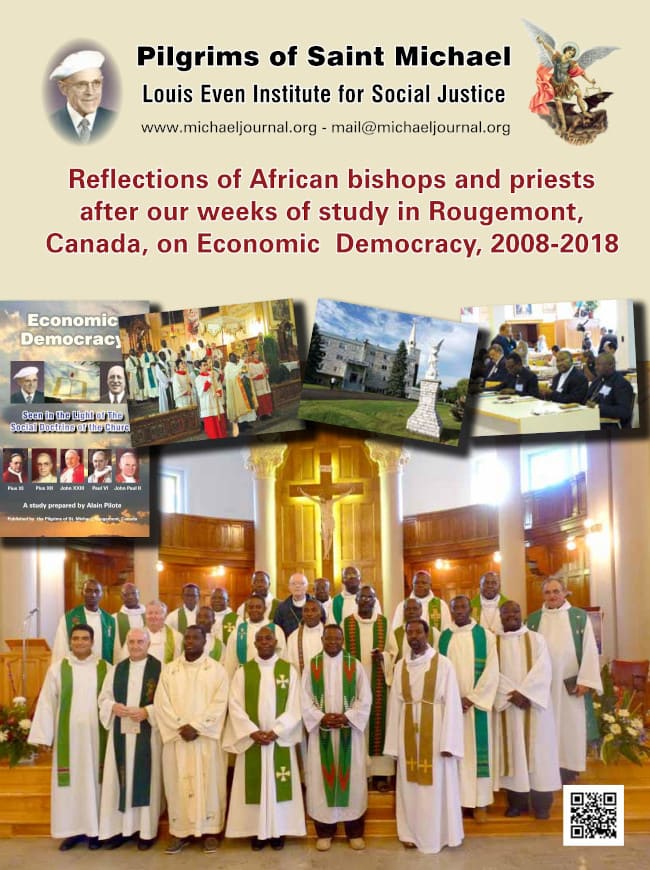|
|
|
A negative of the Holy Shroud |
Last May 2, Pope Benedict XVI went to Turin, Italy, to pray before the Holy Shroud, a centuries-old linen cloth that bears the image of a crucified man, a man that millions believe to be Jesus of Nazareth. (The Church says that it is not a matter of Faith, so people are free to believe or not that it is the real Shroud.) It looks as if, when Jesus resurrected, He took on a glorified body, shining with brilliant light, just like on the occasion of His Transfiguration, and this light left His imprint on the shroud. If it is really this linen that wrapped the body of Our Lord just before His Resurrection, this would be the most extraordinary artifact in history, a proof of the reality of the Resurrection of Our Lord.
So one can understand why the Holy Shroud has been the subject of hundreds of thousands of studies and researches, with the most sophisticated methods — in fact, the Holy Shroud is the most studied artefact in history. And after all those studies, no one has yet been able to explain how this image of a crucified man has been done. In fact, only Faith can explain it. Even those who came to the conclusion that the fabrics date from the fourteenth century still could not explain the fabrication of this image. For those who do not have the Faith, this piece of linen is really mind-boggling; and remains a mystery.
Here are some of the remarks Pope Benedict XVI gave today after venerating the Holy Shroud of Turin:
"I thank God for the gift of this pilgrimage, and also for the opportunity to share with you a brief meditation, which was suggested to me by the title of this solemn exhibition: "The Mystery of Holy Saturday." One could say that the Shroud is the icon of this mystery, the icon of Holy Saturday. It is in fact a winding sheet, which covered the corpse of a man who was crucified, corresponding to everything that the Gospels say of Jesus, who was crucified about noon and died at about 3 in the afternoon. (…)
 |
| Pope Benedict XVI praying before the Shroud |
"This face, these hands and these feet, this side, this whole body speaks, it is itself a word that we can hear in silence. How does the Shroud speak? It speaks with blood, and blood is life! The Shroud is an icon written in blood; the blood of a man who has been scourged, crowned with thorns, crucified and wounded in his right side. Every trace of blood speaks of love and of life. Especially that large mark near the side, made by blood and water that poured copiously from a great wound caused by a Roman spear, that blood and that water speak of life. It is like a spring that speaks in silence, and we can hear it, we can listen to it, in the silence of Holy Saturday.
"Dear friends, let us praise the Lord always for his faithful and merciful love. Departing from this holy place, we carry in our eyes the image of the Shroud, we carry in our heart this word of love, and we praise God with a life full of faith, of love and of charity."
The Holy Shroud is a "challenge to our intelligence," an "image that everyone sees but no one can explain," a mystery that is a subject for deep meditation, and an extraordinary token of the love of God for us. Pope John Paul II had also prayed in front of the Shroud of Turin on May 24, 1998. Here are some excerpts from what he said on that occasion:
|
|
|
The face of Jesus obtained by NASA in 1978 with the use of techniques of image processing, from photographic negatives of the Shroud of Turin. |
"The Shroud is a challenge to our intelligence. It first of all requires of every person, particularly the researcher, that he humbly grasp the profound message it sends to his reason and his life. The mysterious fascination of the Shroud forces questions to be raised about the sacred Linen and the historical life of Jesus. Since it is not a matter of Faith, the Church has not specific competence to pronounce on these questions. She entrusts to scientists the task of continuing to investigate, so that satisfactory answers may be found to the questions connected with this Sheet, which, according to tradition, wrapped the body of our Redeemer after He had been taken down from the Cross. The Church urges that the Shroud be studied without pre-established positions that take for granted results that are not such; she invites them to act with interior freedom and attentive respect for both scientific methodology and the sensibilities of believers. (…)
"Before the Shroud, the intense and agonizing image of an unspeakable torment, I wish to thank the Lord for this unique gift, which asks for the believer’s loving attention and complete willingness to follow the Lord. (...)
"For the believer, what counts above all is, that the Shroud is a mirror of the Gospel. In fact, if we reflect on the sacred Linen, we cannot escape the idea that the image it presents has such a profound relationship with what the Gospels tell of Jesus’ passion and death, that every sensitive person feels inwardly touched and moved at beholding it. Whoever approaches it is also aware that the Shroud does not hold people’s hearts to itself, but turns them to Him, at whose service the Father’s loving providence has put it. Therefore, it is right to foster an awareness of the precious value of this image, which everyone sees and no one at present can explain. For every thoughtful person it is a reason for deep reflection, which can even involve one’s life.
"The Shroud is thus a truly unique sign that points to Jesus, the true Word of the Father, and invites us to pattern our lives on the life of the One who gave Himself for us. (...)
|
|
|
How Christ was buried in the Shroud, a painting of Giulio Clovio (1498-1578) |
"The Shroud is also an image of God’s love as well as of human sin. It invites us to rediscover the ultimate reason for Jesus’ redeeming death. In the incomparable suffering that it documents, the love of the One who ‘so loved the world that he gave his only Son’ (Jn 3:16) is made almost tangible and reveals its astonishing dimensions. In its presence believers can only exclaim in all truth: ‘Lord, you could not love me more,’ and immediately realize that sin is responsible for that suffering: the sins of every human being.
"As it speaks to us of love and sin, the Shroud invites us all to impress upon our spirit the face of God’s love, to remove from it the tremendous reality of sin. Contemplation of that tortured Body helps contemporary man to free himself from the superficiality of the selfishness with which he frequently treats love and sin. Echoing the word of God and centuries of Christian consciousness, the Shroud whispers: believe in God’s love, the greatest treasure given to humanity, and flee from sin, the greatest misfortune in history. (...)
"This icon of Christ abandoned in the dramatic and solemn state of death, which for centuries has been the subject of significant representations, and for 100 years, thanks to photography, has been so frequently reproduced, urges us to go to the heart of the mystery of life and death, to discover the great and consoling message it has left us. The Shroud shows us Jesus at the moment of his greatest helplessness, and reminds us that in the abasement of that death lies the salvation of the whole world. The Shroud thus becomes an invitation to face every experience, including that of suffering and extreme helplessness, with the attitude of those who believe that God’s merciful love overcomes every poverty, every limitation, every temptation to despair.
"May the Spirit of God, who dwells in our hearts, instill in everyone the desire and generosity necessary for accepting the Shroud’s message and for making it the decisive inspiration of our lives. Soul of Christ sanctify me, Body of Christ save me, Passion of Christ console me, in Your wounds hide me." (End of Pope John Paul II’s meditation.)
The Shroud is a linen sheet, 4.36 metres long by 1.10 metres wide. Other than the two dark parallel lines with the white triangles (burn marks from the Chambery fire in 1532), the imprint of an image (a negative) — front and back — of a man who died from crucifixion, with nails in his hands and feet, is clearly visible.
The Shroud arrived in Turin in 1578 from Chambery, then the capital of the Duchy of Savoy, and it has been kept in the Turin Cathedral ever since. Reliable historical documents record the Shroud’s movements, without interruption, from the mid-fourteenth century. It is known that in the 1350s, the Shroud was in Lirey, France, and perhaps previously it was in the East, initially in Edessa and later in Constantinople, before being brought to Europe during the Crusades.
In 1453, it was ceded to Duke Louis of Savoy, and it followed the ruling family when the capital of Savoy was transferred to Turin, in 1478. Since 1694, it has been kept (brief interruptions aside) in the splendid chapel built between the Cathedral and the Royal Palace. Umberto II left the Shroud to the Pope in his will, and in 1983, it became the property of the Holy See.
Modern scientific interest in the Shroud can be said to have begun in 1898 when the Italian photographer, Secunda Pia, took the first photographs of the Shroud. While he was making a photographic print, Pia noticed that the negative image on the Shroud looked very much like a photographic positive. This discovery raised scientific eyebrows, and then began a continuous and growing scientific interest in the Shroud until the present day. The negative of that photograph revealed in detail, and with even greater clarity than the positive image, all the "wounds" that the Shroud preserved. How was the image on the Shroud formed? Science has not yet come up with any plausible explanations. Below is a list of definitive results from research carried out during this century:
The image is not a painting and it was left by the corpse of a man who was beaten and crucified. Computer processing has shown that the image has three-dimensional properties, something which neither paintings nor standard photographs possess; pollens have been found on the cloth, strongly supporting the view that the Shroud spent time not only in Europe, but also in the Near East; tests on traces of blood from the Shroud have revealed the presence of human blood from blood group AB; there is no body image under the bloodstains, so the image must have formed subsequently.
 |
| The Shroud as it appears to the naked eye (left) and its negative photograph (right), where the wounds are more visible. |
The body image is the result of a molecular change in the linen cellulose. No extraneous chemical agents of any significance were detected that could be associated with the image. The possibility that the Shroud of Turin is the burial cloth of Jesus comes primarily from a consideration of the many wounds found on the Shroud. In particular, the evident wounds of crucifixion in the wrists and feet, numerous scourge-like marks over the back, puncture wounds on the top of the head, and a wound in the side all correlate well with the New Testament accounts of the Passion of Jesus.
Barrie M. Schwortz, an Orthodox Jew, was a member of the team that completed the first extensive scientific examination of the Shroud of Turin in 1978, being the official documenting photographer for the team, taking more than 2,700 pictures of the Shroud. He said, twenty years later:
"Frankly, I am still Jewish, yet I believe the Shroud of Turin is the cloth that wrapped the man Jesus after he was crucified. That is not meant as a religious statement, but one based on my privileged position of direct involvement with many of the serious Shroud researchers in the world, and a knowledge of the scientific data, unclouded by media exaggeration. The only reason I am still involved with the Shroud of Turin is because knowing the unbiased facts continues to convince me of its authenticity. And I believe only a handful of people have really ever had access to all of the unbiased facts. Most of the public has had to depend on the media, who always seem to sensationalize the story or reduce the facts to two-minute sound bites from so-called experts who have ‘solved the mystery.’"
In 1988, carbon-14 dating was carried out on a fragment of the Shroud. The results date the fabric to be between 1260 and 1390 A.D. The scientific community itself now questions these results, and more recent experimental studies have reopened the debate, because the 1532 fire deposited more carbon-14 than normal in the area where the sample was taken, thus flawing the results. (This is why Pope John Paul II asked "not to take for granted results that are not such.") Being that the totality of the various types of historical and archaeological data concerning the Shroud are sufficiently compelling towards authenticity, it is unwise to tacitly accept the radiocarbon date without a rigorous critique of its applicability to the Shroud. For example, the late Dr. Max Frei reported finding numerous pollens on the Shroud from plants that grow only in the Middle East (and not in Europe). If the Shroud dates only from the fourteenth century, and we know historically that it has been in Europe continuously from that time, then we must critically ask: how did all the pollens from the Middle East come to exist on the Shroud?
Let us thank God for this extraordinary "memento" of His Passion and let us seek the Holy Face of Jesus in all of our brothers and sisters!
 In this special issue of the journal, MICHAEL, the reader will discover who are the true rulers of the world. We discuss that the current monetary system is a mechanism to control populations. The reader will come to understand that "crises" are created and that when governments attempt to get out of the grip of financial tyranny wars are waged.
In this special issue of the journal, MICHAEL, the reader will discover who are the true rulers of the world. We discuss that the current monetary system is a mechanism to control populations. The reader will come to understand that "crises" are created and that when governments attempt to get out of the grip of financial tyranny wars are waged. An Efficient Financial System, written by Louis Even, is for the reader who has some understanding of the Douglas Social Credit monetary reform principles. Technical aspects and applications are discussed in short chapters dedicated to the three propositions, how equilibrium between prices and purchasing power can be achieved, the financing of private and public production, how a Social Dividend would be financed, and, finally, what would become of taxes under a Douglas Social Credit economy. Study this publication to better grasp the practical application of Douglas' work.
An Efficient Financial System, written by Louis Even, is for the reader who has some understanding of the Douglas Social Credit monetary reform principles. Technical aspects and applications are discussed in short chapters dedicated to the three propositions, how equilibrium between prices and purchasing power can be achieved, the financing of private and public production, how a Social Dividend would be financed, and, finally, what would become of taxes under a Douglas Social Credit economy. Study this publication to better grasp the practical application of Douglas' work.  Reflections of African bishops and priests after our weeks of study in Rougemont, Canada, on Economic Democracy, 2008-2018
Reflections of African bishops and priests after our weeks of study in Rougemont, Canada, on Economic Democracy, 2008-2018 The Social Dividend is one of three principles that comprise the Social Credit monetary reform which is the topic of this booklet. The Social Dividend is an income granted to each citizen from cradle to grave, with- out condition, regardless of employment status.
The Social Dividend is one of three principles that comprise the Social Credit monetary reform which is the topic of this booklet. The Social Dividend is an income granted to each citizen from cradle to grave, with- out condition, regardless of employment status.Rougemont Quebec Monthly Meetings
Every 4th Sunday of every month, a monthly meeting is held in Rougemont.